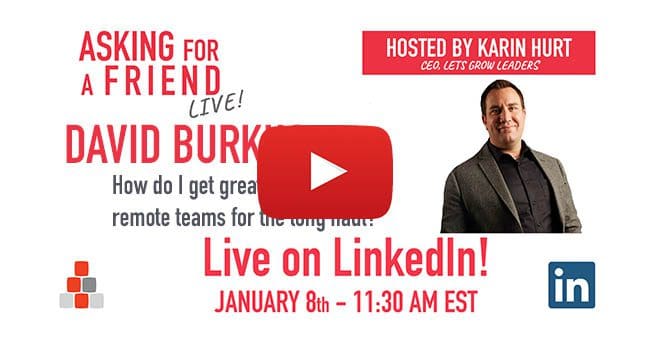In this interview with David Burkus, author of the new book Leading From Anywhere, we talk about leading remote teams for the long haul and practical tools and approaches to take your remote leadership to the next level.
Advanced Skills for Leading Remote Teams
- Connect your team to meaningful vision and purpose, “Ask, what are we fighting for?”
- Create psychological safety (for more on this read our Courageous Cultures foreword by Harvard’s Dr. Amy Edmonson)
- Avoid disruption through more deliberate synchronous and asynchronous communication
- Hold shorter, purpose-driven meetings
- Nurture creativity and new ideas by breaking down conversation (issue, ideas, decisions)

If you’re looking for more tools and resources for leading remote teams, visit our Let’s Grow Leaders remote team’s resource center.
Linkedin LIVE on Leading Remote Teams with David Burkus and Karin Hurt (Transcript Highlights)
Connecting Your Team to Meaningful Mission and Purpose
Ask “What are we fighting for?”
How do I make the mission and vision of the company, affect people’s day-to-day lives? And the irony is the engagement numbers haven’t moved, right?
David Burkus (02:49):
In some cases, they’ve gotten worse, but I’m going to blame that on a lot of different factors. But it, it hasn’t moved the needle.
And I think one of the questions is that there’s not that sense of clarity and there’s not that sense of where we’re really working toward something important, something that will make the world a better place.
And so I started cutting through all of that and asking teams or even individuals when it came to mission and purpose, I would go, you know, I don’t care if you know it, most companies write such a complicated mission statement that like, I wouldn’t be able to memorize it either.
But when I asked them the question,
“Hey, you know, when we think about our organization, what are we fighting for?”
What About Psychological Safety When Leading Remote Teams?
David Burkus (07:53):
And when, when people invest trust in us, it releases that oxytocin, we’re more likely to respond with trustworthy behavior. And so if you’re a leader looking to actually build trust in a team, you need to think about it that way.
What are the things you can do to demonstrate that you actually already trust your people?
This is an interesting conversation by the way, in this world of work from anywhere.
David Burkus (08:38):
So as a leader, I think it’s a little bit of letting go that you have to do…. One of the biggest things you can do is when you’re working early with a team and they’re looking to you to make a decision, make sure you’re demonstrating the rationale behind that decision. Not just because here’s what it is, but you want to be understood. You want people to understand how you’re thinking so that gradually you can actually delegate that decision once your team has a great idea of that kind they have learned from you, what you think and, and the wisdom that you have to give the rest of the team. You can let them make the decision.
David Burkus (09:13):
And then you end up usually at a very similar decision, but through a sense of trust and a sense of camaraderie that wouldn’t have happened if you just snapped to that decision. Right? So little things you can do like that. I think that also means not engaging in a uniform standard of checking in with people. You know, you don’t need to do a 15 minute zoom call all Friday, stack the ball on Friday afternoon. And then again on Monday to say, what are you going to work on this week? Everybody manages their workflow a little bit differently, especially in this environment and the leaders who actually trust their people are the leaders who go through that feeling out process to find out how can I make sure that you have the autonomy to work? However you want. You don’t feel like I’m breathing down your neck, but you know, I’m here for you anytime you need help.
On Trust and Security
Karin Hurt (09:54):
Yeah. It’s so interesting. About eight years ago, uh, I was involved in this experiment of having call center agents working from home and it was so fascinating. I mean, the dealing with it, dealing with the security, dealing with CPNI issues…
We talked about, Oh, should we put cameras in people’s offices so we can watch them like radically different conversation. And now I’m laughing because I watched, you know, our call center clients in one week back in March, move everybody home. They’re where they’re at right now. It’s amazing how, in a sense of urgency, how see how much simpler it got and guess what it’s working out. Great.
David Burkus (10:39):
I remember a lot of rhetoric in April and May about what software systems should we use the monitor employees, fancy term for spying on them. And that’s, and I just remember thinking again, through this idea of trust and autonomy, mutual respect, psychological safety, that like, if you couldn’t, if you couldn’t send your call center employees home on a week’s notice and trust that they would do their job without being monitored, you screwed up a long time ago, right?
How Do I Create Boundaries Between Work and Home?
Karin Hurt (11:23):
What you were writing was reminding me of the conversations I’m having literally every day, which is people are not finding that their employees are not working enough. They’re finding that their employees are working too much. I think, and this is, I think this is the next big problem we’re going to have is that more and more people are going to be burned out, stressed out and they can’t have the boundaries. And what I like is that you really did give some, we’re all about really practical advice on this, like really practical ways to do that. Can you share a few of those tips?
David Burkus (12:43):
And so everything that we can do as leaders to help people avoid burnout is really about making those distinctions that’s the little things. Right? So that can be little things like teaching people to set business hours, not the normal nine to five, but to actually plan it out in your calendar, when are you going to be working? And when are you not so that, you know you’re off right now, or rituals, are you going to use that replace the commute? Right. So like for me I have two devices and when I leave this room, which is in the basement of our house, when I leave this room, I go upstairs to a charging station and I switched my phone for a tablet. The tablet has nothing work-related on it. It’s like my personal Facebook account and then Netflix and Kindle and, and that’s it.
What Can Senior Leaders Do to Model the Way?
Karin Hurt (14:14):
So Jonathan Green, who is also a friend of mine (coming in the LinkedIn Live chat) says leadership not disconnecting is a real issue when leading remote teams. So I want to turn that into a question.
“What do you do if your leaders are not turning it off? They’re not setting boundaries, but they’re telling you, it’s okay for you too?”
David Burkus (14:33):
Yeah. So this is a huge problem that predates the great work from home experiment, right? The idea that we care about work-life balance and you being off work, but we’re also sending you emails at 1130 at night, right. Um, and this is something that, that really needed to stop, um, kind of a long, long time ago. I think now the best thing you can do is be first, you’ve got to commit to disconnecting. If you say that our work hours are this, or you say that are times where we don’t expect email responses, this is actually the big one for a lot of leaders. If you say that 24 hours is a reasonable amount of time to wait for an email, then you have to wait 24 hours. Right. So it starts with you and it starts with drawing those up.
The irony…
David Burkus (15:12):
The irony, of course, is that leaders are the most burnout by this whole thing that we’ve been running through. So they’re the biggest incentive to be the ones drawing up those boundaries. And then when you have those boundaries be showy about those boundaries, right? You don’t need to apologize if someone sends you an email at 6:00 PM and you don’t reply till six 30. Right. You don’t have to say, Oh, I’m sorry, I’m just seeing this.
Of course, you’re just seeing this now, because you turned off that device at five o’clock. Right. Um, so I think those little things go a long way. I think the problem is, like you said, about challenges with it before. Well, one of the, one of the big problems is this is a senior leadership and it level issue, but it’s also a team issue. And so if you can’t get senior leadership to go, yeah, we probably should turn off the email servers at some point at night and turn them back on at 8:00 AM. Then you, as a leader, need to have that discussion with your team to go, okay, what are the standards we’re committing to inside of this team? And then hold, hold yourself accountable to them first and let other people, I don’t want to say fall in line, but follow your lead.
Communication in Remote Teams
Karin Hurt (20:48):
Okay. I want to shift gears to my favorite part of your book because this is, this is an area, this concept of in remote work environment, synchronous communication, asynchronous communication. And I’m going to share with you my favorite sentence from your book.
So you say asking employees to keep a group chat open is like demanding they attended all day meeting with no agenda where participants come in and out at random and speak only in sentence fragments, as you’re asking them to commit to the work that they’re doing right here, what could go wrong?
David Burkus (22:39):
The problem is that a lot of us choose tools that were actually designed for asynchronous communication and then have expectations that it’s synchronous, whether that’s expecting an email reply in the next hour or feeling like you always have to be in that Slack channel because if you’re not, you might miss something. And that the tools are getting a little better than this like threaded discussions in Slack actually make it a totally different tool.
And when it was like, if it was like trying to do a business meeting and a Chucky cheese before that but, but the point is we can’t pick the right tool until we break out of that and have that conversation. What are the subjects of the issues and the types of communication we need to commit to as being asynchronous, project updates, requests for help, all of those sort of things can usually be asynchronous? And then what are the things and the subjects and the times that we want to have synchronous communication. Once we settle that, then we can think about what the tool for talking about those specific issues is, right? It’s usually not Slack, by the way, it’s usually a project management software. If you’ve committed to the idea that this is asynchronous communication.
Your turn.
What would you add? What are some of your best-advanced strategies for leading remote teams?








0 Comments